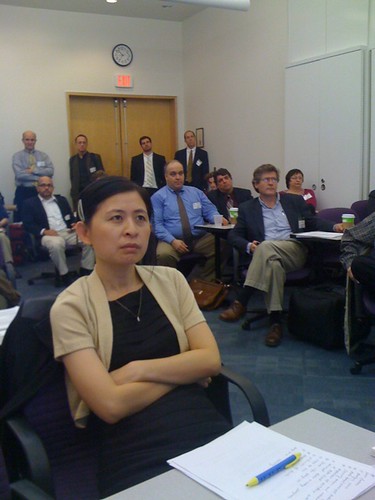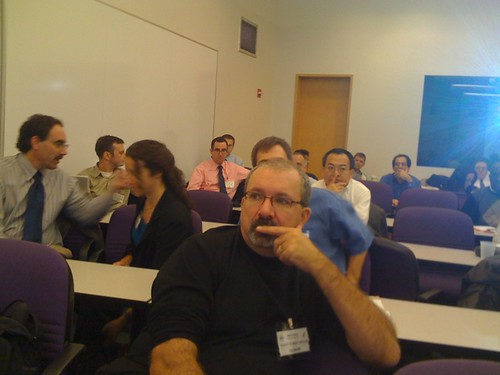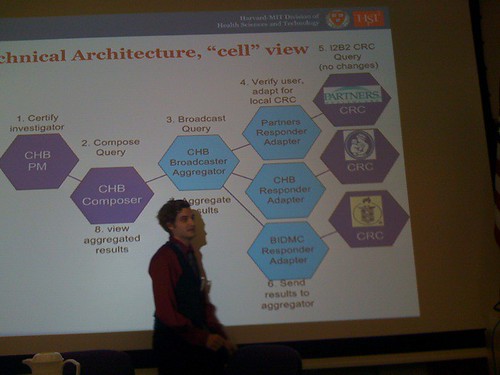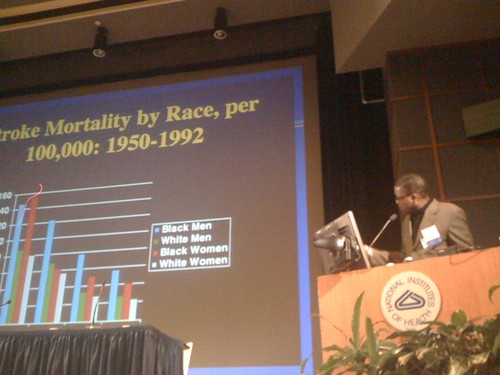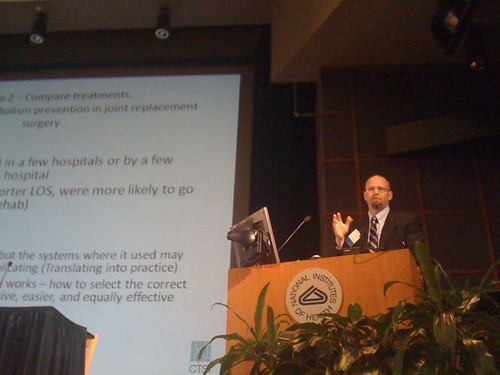Zak Kohane summarized some of the new i2b2-based projects that recently were announced including a South Carolina consortium (a GO grant funds the automated consent component), a pediatric rheumatology research network including 60 sites (NIH GO grant), Shawn Murphy is working with an imaging consortium to better integrate images into i2b2 instances (CTSA administrative supplement) using XNAT/BIRN infrastructure, and B.U. and U. Mass received a GO grant to study health disparities using i2b2 as infrastructure. Lynn Bry received a 2 year R01 under ARRA for the Crimson-i2b2 integration project.
Susanne Churchill welcomed the group and noted that there is a consortium of European i2b2 users/implementors/refiners that are putting together a proposal for joint work across the European Union (for EU funding). She noted that the AUG now numbers over 100 and represents 30 healthcare/academic institutions including 5 internationally.
Shawn Murphy summarized several new developments including
- Release Candidate 1.4 to support the Enterprise including: analysis views, improved role-based access and auditing, replacement of Gridsphere with webservices and AJAX client, Microsoft Active Directory integration, obfuscation of results for privacy purposes.
- In the future, the distributions of i2b2 be via configurable VM's so that the functionality can be attached to local databases without requiring a full install. The full source code compile and install will still be available.
- Eclipse plug-in "store" where developers can contribute their own plug ins and where users can download the plugins they want.
- More support for derived data (e.g. to systematically return NLP concepts derived from the clinical notes
Lynn Bry described the Crimson system and how i2b2 discarded sample have far higher utilization rates than other samples (e.g. for biorepositories). She also described the Sample Ontology and how she is borrowing from WHO and SNOMED to standardization. The system includes an ontology manager to allow local ontology management and update samples. Also described are the IRB permissions data from RC 1.4. Will work towards multisite studies within the two year implementation time frame. Lynn described the Enterprise Master Specimen Index that tracks samples and patient relationships in various levels of identity (consented identified, de-identified, and anonymous samples).
Dan Housman and Peter Emerson from Recombinant were invited into the AUG for the discussion segment about sample management (because of the AUG's wish to keep companies at arm length) to discuss their own efforts in sample management. They made it clear that all their developments they are involved in will be contributed back to the i2b2 community as fully open source code.
Andy McMurry summarized the status of the distributed querying system called SHRINE that is now implemented at several Harvard-affiliated hospitals and several West Coast academic health centers (e.g. UCSF and UW) that is now fully IRB approved (at Harvard) for queries returning aggregate numbers (across demographics, laboratory results, medications and diagnoses). Andy also made a very clear several technical hurdles that were overcome including the ontology matching process (on the fly). Finally, he announced the availability of SHRINE code in a fully open source codebase.
i2b2 CICTR presented by Nick Anderson. They have been able to query muiti-institutional "anonymized PHI data". Application is in diabetes and cardiovascular disease. Described technical, governance, ontology and evaluation process that CICTR is driving. Nick described the heterogeneous systems that CICTR has to query across. Nick distinguished the need for high level institutional support which is a sine qua non requirement for success and the need for a broad range of paid technical personnel.
Keith Marsolo from Cincinnati's Children's reported on their Epic roll out and how that relates to their i2b2. Described their quality assurance efforts. Notes the challenge of the firehose and makes the acute observation that most investigators just want a spreadsheet and anything more complicated than that tends to get ignored. Keith also emphasized their goal to allow streamlined adding of research data to the clinical data. He makes the important point that "age at FACT" is essential for pediatric applications to allow them to be easily accessed in the i2b2 workbench. Keith mentioned using i2b2 for research databases for Eosinophilic esophagitis, and IBD.
Phil Reeder from UT Houston talked about medications mapping. It is a challenge and they have chosen to map to RxNorm and then manually had to map into SNOMED CT (perhaps their database was out of date). Started from an All Scripts database and had a semi-automated process. Notes that every year there are at least a 1000 new drugs (i.e. different packaging, pill sizes etc). Brought up the thorny (and annoying IMHO) of the proprietary mappings to standard vocabularies.
Ralph Zottola and Edward Westrick described the effort at U. Mass (data sourced from Meditech system, REDcap EDC, biorepository, EMPI, Allscripts, and departmental systems) where they are up to 2,000,000 patients. Edward described the managed care network (1000 physicians) that plugs into U. Mass and how quality measures inform the discussions and bargaining with payors. Reviewed different measures including HEDIS, patient experience, was well as the increasingly important Relative Resource Utilization (Efficiency). Demonstrated how knowing what is going on in the healthcare institution allows for a sober and leveraged discussion with payors. The healthcare system approached the medical school and settled on i2b2 and they already have seen that they can accurately forecast their performance and to provide a feedback loop (with financial incentives) to healthcare providers. Ralph pointed out that the fact that clinical operations are using i2b2 is also causing an improvement in the quality of the data being delivered to the data marts.
Iain Sanderson and Jihad Obeid. Iain started by describing a very comprehensive Informatics Initiatives in South Carolina. They have a unified IRB with a goal of clinical trials across the state. There is both a scientific and a funding motivation in this. There are three informatics initiatives have dovetailed (CTSA biomedical informatics, HSSC IT business plan, and a GO grant on consent). This has resulted in the South Carolina Integrated Platform for Research (SCIPR) that uses i2b2 for the clinical research data warehouse. In the process they are adopting a wide range of open source solutions including Sun Microsystems' JavaCaps. Iain reports that the data sharing agreements between the 6 centers across HSSC are under way and likely to result in an MoU in short order. Iain also described the beginnings of the consent management/gathering system, the permissions ontology and documenting the different consent processes at the institutional members of the HSSC. Finally, Iain discussed how personal patient health portals may be used to provide the patient-facing part of the network.
